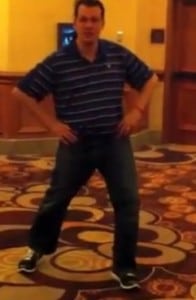
While I was at a recent mastermind conference, I was interviewed by Maria Mountain.
I thought what I went through would be of benefit to you, so here you go.
Enjoy!
Rick Kaselj, MS
===
Hey gang, it’s Marie Mountain here from GoalieTrainingPro.com. I am hooking up with my friend Rick Kaselj, at our top secret Mastermind Conference in Las Vegas. Rick specializes in exercises for injuries, so not exercises to make you injured, but ones to help you get back on the playing field after you have been injured.
We were chatting a little bit about stretching and multiplanar stretching. This is something we have talked about here previously. Given he is an expert in this field, I am going to let him chat about how this can help you reduce your risk of groin injuries and keep you in the game longer.
CLICK HERE to watch the YouTube video.
As Maria said, my name is Rick Kaselj and I want to chat with you about stretching. How I use stretching falls into two groups:
- Static Stretching – You are holding the stretch and not moving. You are getting the muscle to lengthen and relax. Often, this is something that you do after your workout, after your practice, or after your game.
- Dynamic Stretching – You are going through various movements as you lengthen out the muscle. It’s something like a dynamic warm up.
A big thing that you need to focus on is moving and being stabilized in various planes of movements. To break that down, you have forward and backward movement, which is called the Sagittal Plane movement. We also have side to side movement, called Frontal Plane movement. Lastly, we have twisting movements, called Transverse Plane movements.
With hockey, you might do side to side movements when it comes to moving post to post, and that ends up being frontal plane work. But a lot of times what you are doing is a combination of those planes of movement. You are moving forward, back, side to side, and twisting. It is important when you are doing your static stretching and when you are doing your dynamic stretching or dynamic warm up to combine those planes of movement.
Let me go through some examples.
If we want to focus on the frontal plane movement in the groin, we are going to do a side stretch, perfectly going side to side.
Frontal Plane Movement
But if I wanted to start incorporating various planes of movement, I would step back with one leg. Now, I’ve changed my groin position and kind of moved it in that sagittal plane. I can add some rotation in that hip, so I’m in the transverse plane and I am moving to the side.
Sagittal Plane Front with Transverse Movement
Give that a go.
Remember, stretch in a single plane of movement but also stretch a combination of planes in order to get better results.
If you are looking for a program to help you improve your hip flexibility, then check out Unlock Your Tight Hip Flexors, here.
Rick Kaselj, MS.



